
Error handling in complex spreadsheets is challenging, especially when working with large datasets, complex formulas, or multiple linked sheets. Advanced error-handling techniques help to maintain data accuracy which enhances usability, making it easier to spot and troubleshoot issues. This tutorial will show advanced error handling in complex spreadsheets. It will cover advanced methods to handle errors, enabling smoother data management.
Let’s consider supermarket sales data with some inconsistency to show practical examples of error handling in complex large spreadsheets.
1. Handle Common Errors with IFERROR
You can handle #DIV/0! (Division by Zero Errors) by using the IFERROR function. If you want to calculate the average Sales Amount per unit, you might encounter a division by zero if the Order Quantity is zero. The IFERROR function replaces common errors, such as #N/A, #DIV/0!, and #VALUE! with custom messages or alternative calculations.
Formula:
=IFERROR(F2:F71/E2:E71, "No Quantity")
This formula calculates the average sales amount per unit and displays “No Quantity” if the “Order Quantity” is zero.
Output:

2. Checking for Mismatches with IFNA and Lookup Functions
If you want to pull customer region data from another table or sheet, you might encounter #N/A errors if the customer’s name is not found. You can use IFNA with VLOOKUP to handle missing lookup values gracefully. The IFNA works for #N/A errors specifically.
Formula:
=IFNA(VLOOKUP("Ela Muller", B2:F71,5,FALSE), "Name Not Found")
This formula returns “Name Not Found” if the customer’s name is missing in the lookup table.
Output:
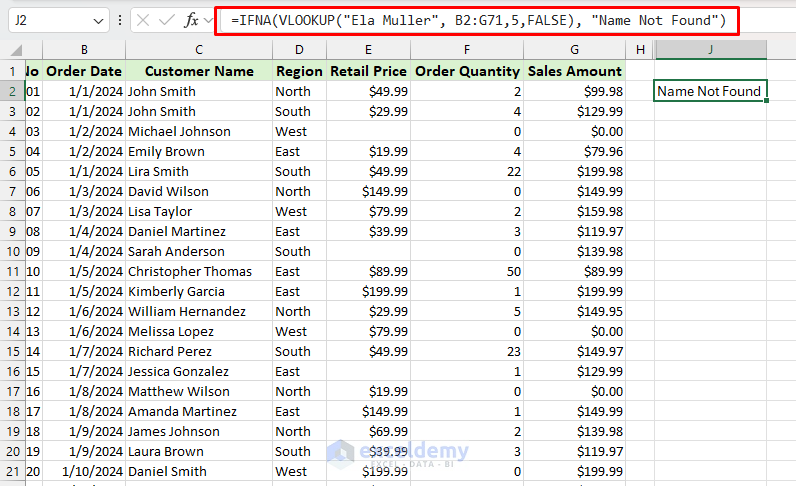
3. Identifying Out-of-Range Values
If you want to ensure that the “Order Quantity” is within a realistic range (e.g., 1-10), you can check for outliers. You can use IF to check if the quantity is out of range:
Formula:
=IF(AND(F2>=1, F2<=10), "Valid", "Out of Range")
This formula returns “Out of Range” if any “Order Quantity” values are outside the expected range.
Output:
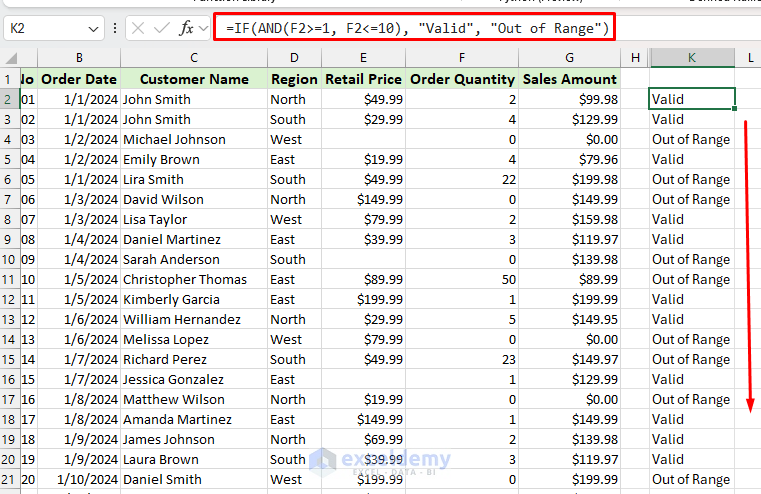
4. Use Custom Error Messages in Data Validation
Data validation can prevent incorrect data entry and help reduce errors before they happen. If you want to ensure that the Region column only contains North, South, East, or West, data validation can help prevent incorrect entries.
- Select the Region column, and go to the Data tab >> from Data Tools >> select Data Validation.
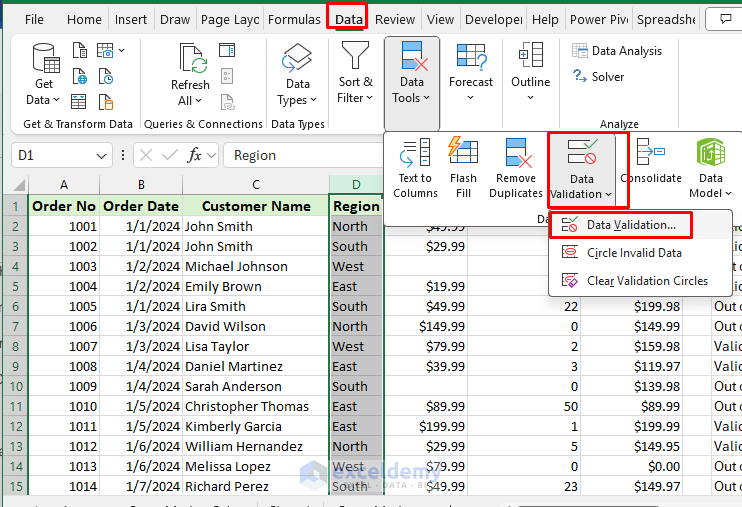
- Set the validation criteria to List with allowed values: North, South, East, West.
- Select the Error Alert tab to display a custom message if invalid data is entered.
- “Region is wrong kindly check the spelling”.

Output:
With any wrong entry in the “Region” column, an error message will pop up.

5. Validating Calculations in Excel
You can validate your calculations to check the errors or missing values. Suppose you want to validate the Sales Amount column, it should be the product of Retail Price and Order Quantity. If there’s a mismatch, it could indicate a data entry error.
You can use the IF function to validate the Sales Amount.
Formula:
=IF(G2:G71=E2:E71*F2:F71, "OK", "Error")
This formula verifies whether the “Sales Amount” is correct or incorrect. Then returns an “Error” if the amounts don’t match.
Output:
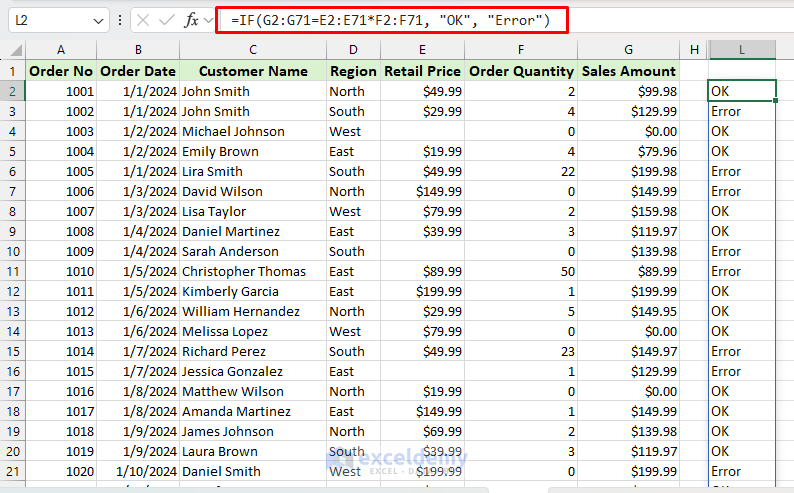
Handling Missing Data:
If some Retail Price values are missing, formulas that depend on these values might result in errors. You can use IF with ISBLANK to provide a fallback value.
Formula:
=IF(ISBLANK(E2:E71), "Retail Price Missing", E2:E71*F2:F71)
This formula calculates the “Sales Amount” and shows “Price Missing” if the retail price is not provided.
Output:

6. Use Array Formulas with Advanced Error Control
Array formulas can perform multiple calculations into a single cell, and with error handling, they help catch issues within complex calculations. Let’s find out the average Retail Price while ignoring errors.
Formula:
=AVERAGE(E2:E71)
The “Retail Price” column has empty cells with null values yet the AVERAGE function will calculate the average retail price.
Output:
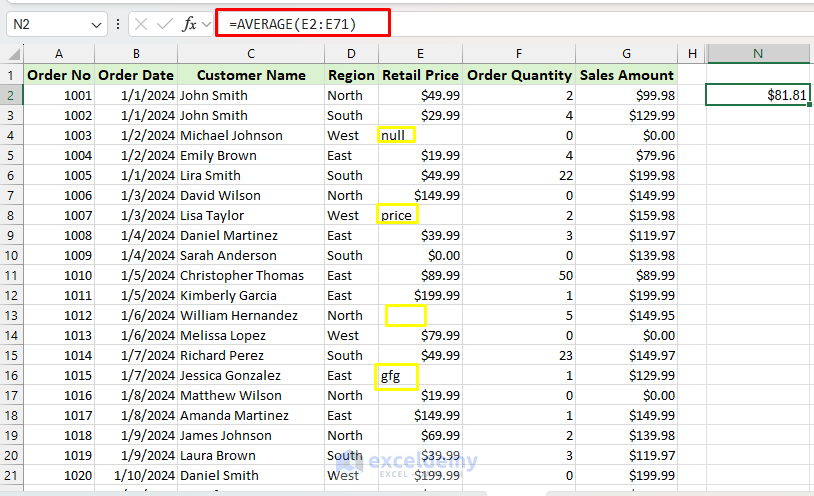
7. Use Error Handling for Linked Workbooks
When linking multiple workbooks, errors can propagate across files if source data changes. You can use the IFERROR around links.
Formula:
=IFERROR([Workbook2.xlsx]Sheet1!A1, "Link Error")
Regularly update links under the Data tab >> Edit Links to avoid broken references.
8. Trace Errors with Formula Auditing Tools
Excel’s formula auditing tools help trace errors back to their source cells, making it easier to pinpoint complex error chains. If the dataset becomes large or more complex, tracking errors can be difficult.
- Go to the Formulas tab >> Select the Formula Auditing section.
- From Formula Auditing tools:
- You can use Trace Precedents and Trace Dependents to visualize relationships.
- You can use the Evaluate Formula which lets you step through a formula to understand where errors arise.
- You can use the Error Checking option to check or trace errors.

Best Practices for Error Handling
- Break complex formulas into smaller parts using helper columns to find errors.
- Consistent messages across formulas make troubleshooting easier.
- Test your error handling by entering invalid data or breaking dependencies intentionally.
Conclusion
Advanced error handling is essential for building reliable and user-friendly spreadsheets. By using built-in Excel functions, formula auditing tools, and data validation, you can ensure your complex spreadsheets are more resilient and easier to maintain. The above examples will help you to use suitable functions for advanced error handling. By following the strategies you can save time, reduce frustration, and make your data processes smoother and more accurate.
Get FREE Advanced Excel Exercises with Solutions!

